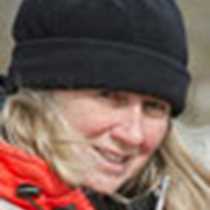Lågøya and the Polar Pack
North. There is nothing between us and the other side of the world except ice. It is a strange feeling to look out toward the pole and see only the sea and sky and floating islands of ice streaming off into the distance. The polar pack is a giant archipelago of drifting floes. At times they accrete one to the other as if converging lithospheric plates interacting to form icy mountain ranges. Or each platter may stand alone, a tiny islet, smooth and flat on top with lacy edges where the sea nibbles at its sides. We push gently against the periphery, an exterior force shoving one against the other and the floor beneath our feet trembles. There is an indescribable sound of ice swishing against ice. One has to hear it to understand.
But we are not alone. Harp seals porpoise from the black reflective water and roll onto their backs, never slowing their forward momentum. Brünnich’s guillemots stand tall on blue-tinged bergy-bits mimicking penguins in the south. Squadrons of their kind flap frantically as they race beside our vessel bound for better foraging grounds beside another floe. In a lead a minke whale repeatedly spy-hops, perhaps assessing the route to follow.
It is here that the King of the Arctic dwells, unbothered by humankind. The attendants of a distant bear tell of its success. Glaucous gulls and ivory gulls patiently wait their turn as blubber is stripped from a flaccid hide. Fat and healthy, another bear dashes at a seal that even more rapidly slides into its breathing hole. Unperturbed this ursine continues its hunt jumping from floe to floe while eyeing us cautiously. We barely move away before encountering a sow and cub. It seems that kids will be kids even if their name is Ursus arctos. Rolling in the water, pawing and batting an ice ball about surely must be play. Is it tolerance that this female exhibits waiting for her unruly two-year-old cub? Repeatedly she leaves her offspring far behind for soon it will be weaned. However he or she apparently still has a lot to learn and mom constantly must return to hustle it along.
Not far to the south lies flat and almost featureless Lågøya, its name translating to just that, the flat island. Gravel strands, pushed into ridges by winter ice are homes to nesting birds. Fiercely defensive Arctic terns tolerate tiny purple sandpipers in their turf but not anything of our size. Red-throated loons call from a myriad of ponds and red phalaropes swirl near the edges. Caribou antlers lie bleached on colorful pebbles as does the skeleton of an elderly expired walrus. We spent our morning here while the pack was wrapped in fog and tucked its memory away to peruse at another time after the ice is far behind.




